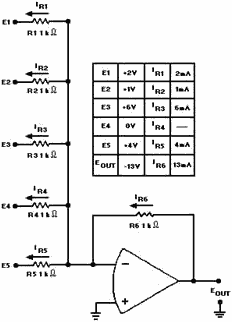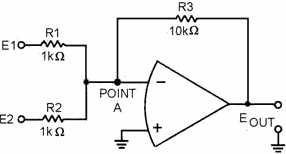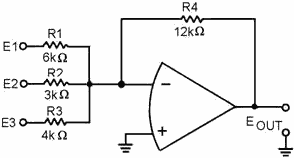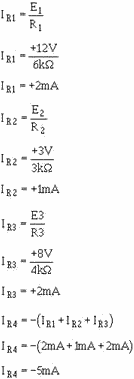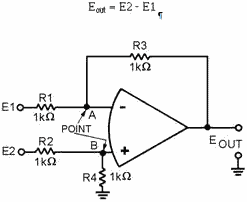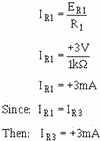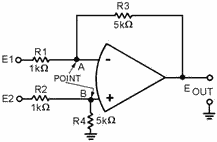Module 8 - Introduction to Amplifiers
|
||||||||||||||||||||||||||||||||||||||||||||||||||
|
Module 8 − Introduction to Amplifiers Pages i, 1−1, 1−11, 1−21, 1−31, 2−1, 2−11, 2−21, 2−31, 3−1, 3−11, 3−21, 3−31, 3−41, 3−51, 3−61, AI−1, Index
An adder circuit is not restricted to two inputs. By adding resistors in parallel to the input terminals, any number of inputs can be used. The adder circuit will always produce an output that is equal to the sum of the input signals but opposite in polarity. Figure 3-22 shows a five-input adder circuit with voltages and currents indicated.
Figure 3-21. - Current and voltage in a two-input adder. 3-31
Figure 3-22. - Five-input adder. The previous circuits have been adders, but there are other types of summing amplifiers. a summing amplifier can be designed to amplify the results of adding the input signals. This type of circuit actually multiplies the sum of the inputs by the gain of the circuit. Mathematically (for a three-input circuit):
If the circuit gain is -10:
The gain of the circuit is determined by the ratio between the feedback resistor and the input resistors. To change figure 3-20 to a summing amplifier with a gain of -10, you would replace the feedback resistor (R3) with a 10-kilohm resistor. This new circuit is shown in figure 3-23. 3-32
Figure 3-23. - Summing amplifier. If this circuit is designed correctly and the input voltages (E1 and E2) are +2 volts and +3 volts, respectively, the output voltage (Eout) should be:
To see if this output (-50 V) is what the circuit will produce with the inputs given above, start by calculating the currents through the input resistors, R1 and R2 (remember that point a is at virtual ground):
Next, calculate the current through the feedback resistor (R3): 3-33
(The minus sign indicates current flow from left to right.) Finally, calculate the voltage dropped across R3 (which must equal the output voltage):
As you can see, this circuit performs the function of adding the inputs together and multiplying the result by the gain of the circuit. One final type of summing amplifier is the SCALING Amplifier. This circuit multiplies each input by a factor (the factor is determined by circuit design) and then adds these values together. The factor that is used to multiply each input is determined by the ratio of the feedback resistor to the input resistor. For example, you could design a circuit that would produce the following output from three inputs (E1, E2, E3):
Using input resistors R1 for input number one (E1), R2 for input number two (E2), R3 for input number three (E3), and R4 for the feedback resistor, you could calculate the values for the resistors:
Any resistors that will provide the ratios shown above could be used. If the feedback resistor (R4) is a 12-kilohm resistor, the values of the other resistors would be: 3-34
Figure 3-24 is the schematic diagram of a scaling amplifier with the values calculated above.
Figure 3-24. - Scaling amplifier. To see if the circuit will produce the desired output, calculate the currents and voltages as done for the previous circuits. With:
the output should be: 3-35
Calculate the current for each input:
Calculate the output voltage:
3-36 You have now seen how an operational amplifier can be used in a circuit as an adder, a summing amplifier, and a scaling amplifier. Difference Amplifier (Subtractor) A difference amplifier will produce an output based on the difference between the input signals. The subtractor circuit shown in figure 3-25 will produce the following output:
Figure 3-25. - Subtractor circuit. Normally, difference amplifier circuits have the ratio of the inverting input resistor to the feedback resistor equal to the ratio of the noninverting input resistors. In other words, for figure 3-25:
and, by inverting both sides:
For ease of explanation, in the circuit shown in figure 3-25 all the resistors have a value of 1 kilohm, but any value could be used as long as the above ratio is true. For a subtractor circuit, the values of R1 and R3 must also be equal, and therefore, the values of R2 and R4 must be equal. It is NOT necessary that the value of R1 equal the value of R2. Using figure 3-25, assume that the input signals are:
The output signal should be: 3-37 Eout = E2 - E1 Eout = (+12V) - (+3V) Eout = +9V To check this output, first compute the value of R2 plus R4:
With this value, compute the current through R2 (IR2):
(indicating current flow from left to right) Next, compute the voltage drop across R2 (ER2):
Then compute the voltage at point B:
Since point B and point a will be at the same potential in an operational amplifier:
Now compute the voltage developed by R1 (ER1):
Compute the current through R1 (IR1): 3-38
Compute the voltage developed by R3 (ER3):
Add this to the voltage at point a to compute the output voltage (Eout):
As you can see, the circuit shown in figure 3-25 functions as a subtractor. But just as an adder is only one kind of summing amplifier, a subtractor is only one kind of difference amplifier. a difference amplifier can amplify the difference between two signals. For example, with two inputs (E1 and E2) and a gain of five, a difference amplifier will produce an output signal which is:
The difference amplifier that will produce that output is shown in figure 3-26. Notice that this circuit is the same as the subtractor shown in figure 3-25 except for the values of R3 and R4. The gain of this difference amplifier is:
Figure 3-26. - Difference amplifier. 3-39
Then, for a difference amplifier:
With the same inputs that were used for the subtractor, (E1 = + 3 V; E2 = + 12 V) the output of the difference amplifier should be five times the output of the subtractor (Eout = + 45 V). Following the same steps used for the subtractor: First compute the value of R2 plus R4:
With this value, compute the current through R2 (IR2):
Next, compute the voltage drop across R2 (ER2):
Then, compute the voltage at point B:
Since point a and point B will be at the same potential in an operational amplifier:
3-40 |
||||||||||||||||||||||||||||||||||||||||||||||||||

